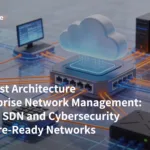
1. Demystifying Hyperconverged Infrastructure (HCI)
At its heart, HCI is an integrated IT framework that merges compute, storage, networking, and virtualization resources into a single, software-defined platform. Unlike the siloed approach of traditional infrastructure, where each component exists as a separate hardware entity, HCI leverages software-defined technologies to unify these elements. This simplification translates to easier management and enhanced scalability for businesses.
2. The Building Blocks of HCI
Several key components work together to form an HCI solution:
- Compute: The workhorses of HCI are compute nodes, typically clusters of multiple servers equipped with processors, memory, and virtualization capabilities. These nodes act as the computational backbone, hosting virtual machines (VMs) and containerized workloads that power your applications.
- Storage: Gone are the days of traditional storage arrays. HCI replaces them with software-defined storage solutions. These solutions pool local storage disks from individual nodes into a shared storage pool, providing a scalable and resilient storage foundation for your data.
- Networking: Software-defined networking (SDN) plays a crucial role in HCI. SDN abstracts network functions, streamlining communication between nodes. This dynamic configuration and optimization of network traffic translates to an agile and responsive system.
3. The Power of HCI: A Multitude of Advantages
For organizations seeking to modernize their IT infrastructure, HCI offers a compelling set of benefits:
- Simplicity: Forget the days of managing a Complex of hardware components. HCI consolidates everything into a unified platform, simplifying deployment, management, and scaling of IT resources. This reduces complexity and frees up valuable IT personnel from tedious tasks.
- Effortless Scalability: As your business grows, so do your IT requirements. HCI allows you to seamlessly scale your infrastructure by adding nodes to existing clusters. This ensures your resources can effortlessly keep pace with your evolving needs.
- Enhanced Efficiency: HCI optimizes resource utilization, leading to improved performance and cost savings. By consolidating infrastructure components, you also gain a smaller physical footprint and reduced energy consumption in your data center.
- Unmatched Flexibility: HCI caters to a wide range of workloads and deployment scenarios, from virtualized environments to cutting-edge containerized applications. This flexibility empowers your organization to adapt to ever-changing business demands with ease.
4. Unveiling the Potential: Use Cases and Deployment Scenarios
HCI’s versatility shines across various industries and deployment scenarios:
- Virtualization Nirvana: HCI is the perfect platform for virtualized workloads. It allows you to consolidate disparate workloads onto a single infrastructure stack, boosting resource utilization and operational efficiency.
- Private Cloud Made Easy: Build and manage your own private cloud environment within your data center. HCI empowers you with agility, scalability, and resource pooling capabilities that rival public cloud platforms, offering greater control and security.
- Taming the Edge: Space, power, and cooling constraints are common challenges at the edge. HCI’s compact footprint and centralized management make it an ideal solution for edge locations with limited IT resources.
- Disaster Recovery with Confidence: HCI architectures streamline disaster recovery with built-in replication and failover functionalities. This ensures data availability and business continuity during outages or unforeseen circumstances.
5. Charting the Course to Successful HCI Implementation
Before diving headfirst into HCI, careful consideration of several factors is crucial. These include selecting the right vendor, ensuring hardware compatibility with your chosen software, and assessing your organization’s readiness for the transition. Successful HCI deployments involve meticulous planning, thorough testing, and ongoing management to guarantee optimal performance and reliability.
Empowering the Future with HCI
Hyperconverged Infrastructure marks a paradigm shift in IT infrastructure management. By offering a unified software-defined platform that delivers simplicity, scalability, and efficiency, HCI empowers organizations to streamline IT operations, enhance agility, and fuel innovation in today’s dynamic business landscape.
Prime Vendors in the HCI arena:
As you embark on your HCI journey, here are some of the leading vendors to consider:
- VMware: A dominant player, renowned for its vSAN software solution.
- Nutanix: A pioneer in the HCI space, offering a unique approach focused on cloud integration.
- Dell EMC: Provides VxRail appliances that seamlessly integrate with VMware technologies.
Conclusion
Hyperconverged Infrastructure (HCI) represents a paradigm shift in IT infrastructure management, offering simplicity, scalability, and efficiency in a unified platform. By converging compute, storage, networking, and virtualization resources into a single software-defined framework, HCI empowers organizations to streamline their IT operations, enhance agility, and drive innovation in today’s dynamic business landscape.
As organizations continue to embrace digital transformation and modernize their IT environments, HCI stands as a cornerstone of next-generation infrastructure, enabling them to unlock new possibilities and stay ahead in an increasingly competitive marketplace.
Why Choose ByteBridge as Your Partner
When it comes to Hyperconverged Infrastructure (HCI), ByteBridge is your go-to choice for several key reasons. First off, our partnership with top HCI vendors like VMware and Nutanix means we know these systems inside and out. Our team has lots of experience setting up and managing HCI solutions, so you can trust us to handle the process smoothly. Plus, we have a track record of successfully completing HCI projects for businesses of all sizes, showing that we know how to get the job done right. What sets us apart is our approach—we don’t believe in one-size-fits-all solutions. Instead, we take the time to understand your unique needs and recommend the best HCI platform for your specific situation. And once your HCI system is up and running, we stick around to provide ongoing support, ensuring it keeps performing at its best. With ByteBridge, you get expertise, personalized service, and ongoing support—all geared towards helping your business thrive with HCI.

About The Author
Madhu Uradi
Madhu has a solid experience in networking and systems and works as a systems engineer at ByteBridge. With certifications in CCNP and JNCIA, his areas of expertise are Data Center, Virtualization, and Wireless. In order to satisfy the evolving needs of modern businesses, Madhu is committed to promoting innovation and offering solutions that are value-driven.






